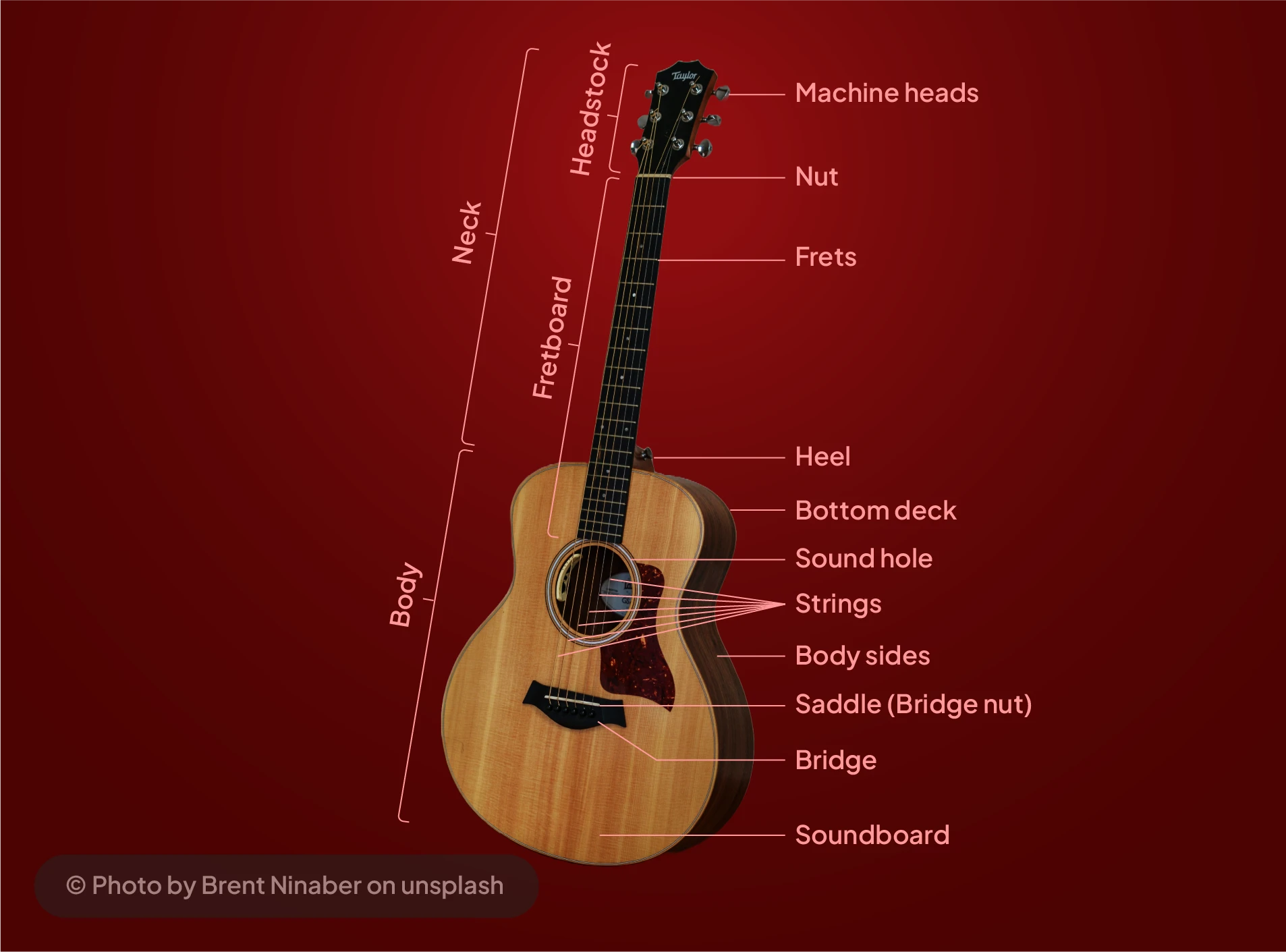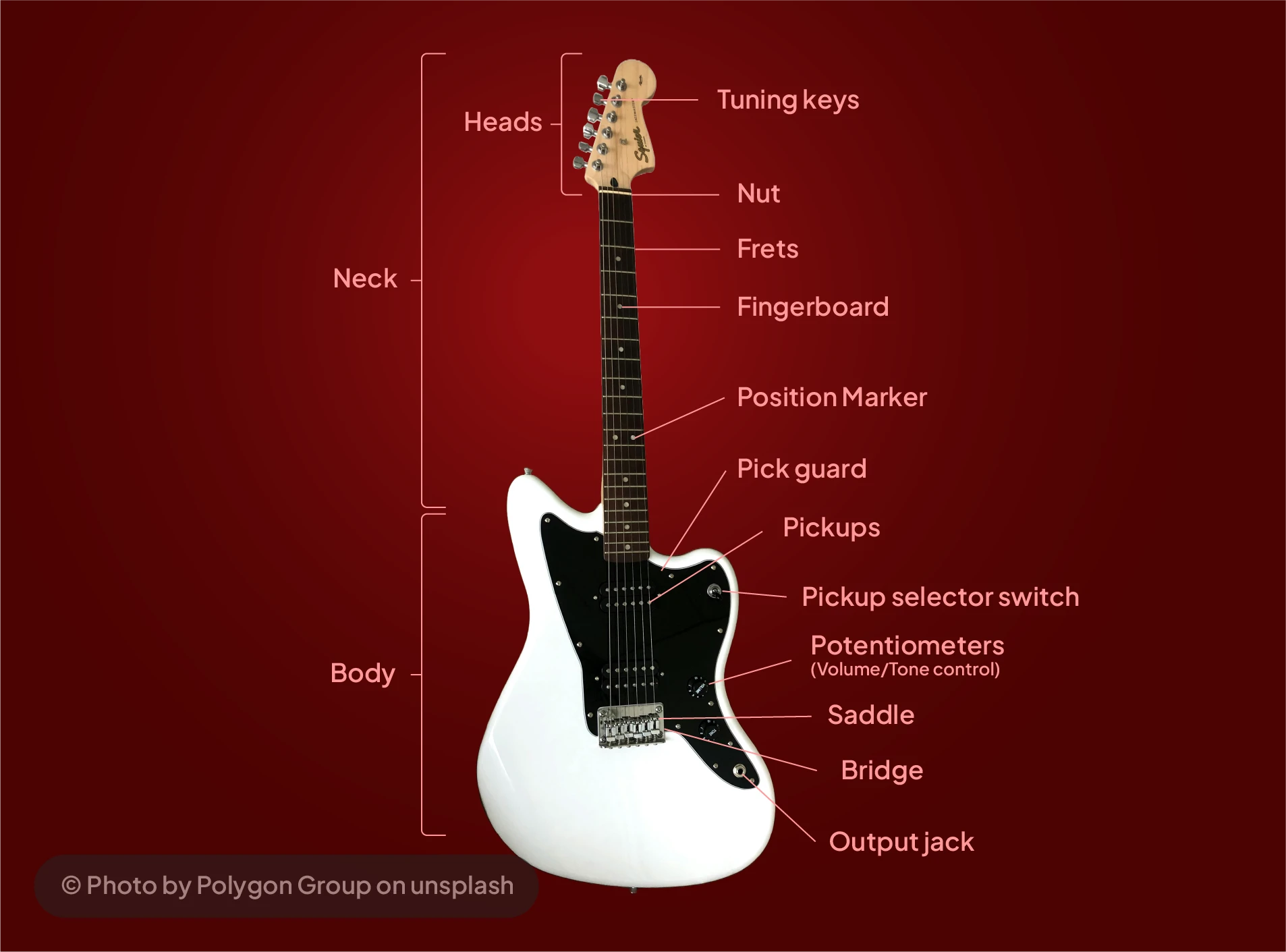Guitar Anatomy: Explore Different Parts of A Guitar
So you have started your musical journey! And you have picked guitar as your ally? That’s great! But before you start strumming and creating stories with melodies, it's important to know the guitar anatomy; their parts, their names, and their role in creating music.
In this blog, we will walk you through the essential parts of the guitars. We will also learn about the components specific to electric guitars, and explain the string names and numbers.
Here are the 11 Parts that All Guitars Have:
1. Headstock
2. Tuners / Tuning Pegs
3. Nut
4. Neck
5. Fretboard
6. Frets
7. Body
8. Bridge
9. Saddle
10. Bridge Pins
11. Soundhole (specific to acoustic guitars)
Let’s break that down a little further.
1. Headstock
As the name suggests, the headstock is located at the very top of the guitar. It holds the tuning pegs and plays a crucial role in keeping the strings aligned and in tune. Depending on the guitar design, the headstock may be straight, angled, or uniquely shaped.
2. Tuners / Tuning Pegs
Tuners are also called tuning pegs or machine heads. These are the knobs you turn to tighten or loosen each string. Tightening a string raises its pitch, while loosening lowers it. Tuners are essential for keeping the guitar in tune and are usually arranged in a row of 3+3 (for acoustic guitars) or 6 in a line (for many electric guitars).
3. Nut
The nut is a small, narrow piece (usually made of plastic, bone, or graphite) located where the headstock meets the neck. It has small grooves to guide the strings from the tuners to the fretboard and helps set the correct string height and spacing at the top of the neck. It also sets the height of the strings over the first fret, affecting playability and tone.
4. Neck
The neck is the long, slender section that extends from the headstock to the guitar’s body. It supports the fretboard and is where your fretting hand does most of the work—pressing strings to form notes and chords. The neck can have different profiles (flat, rounded, etc.) to suit playing comfort.

5. Fretboard (or Fingerboard)
This is the flat surface on the front of the neck, made of wood such as rosewood, ebony, or maple. It’s where your fingers press the strings. Fret markers (dots or other shapes) are often embedded along the fretboard to guide your hand placement.
6. Frets
Frets are the thin metal strips embedded across the fretboard at intervals. Pressing a string down just behind a fret changes its vibrating length, producing different notes. Each fret represents a half-step in musical pitch.
7. Body
The body is the large, central part of the guitar. It’s where sound is produced or amplified, depending on whether the guitar is acoustic or electric. Acoustic bodies are hollow and resonant, while electric bodies are typically solid and designed to hold electronic components.
8. Bridge
Found on the lower part of the body, the bridge anchors the strings and transmits their vibrations to the guitar's top (soundboard). It plays a key role in tone and intonation. Bridges vary in design depending on whether the guitar is acoustic or electric.
9. Saddle
The saddle is a small strip (usually white) that sits in the bridge. The strings rest on the saddle, which sets the action (string height) and affects intonation (accuracy of pitch as you play up the neck). On some guitars, the saddle can be adjusted for better tuning accuracy.
10. Bridge Pins (Acoustic Guitars Only)
These are small pegs used to secure the strings into the bridge. When you replace strings on an acoustic guitar, you remove these pins to insert the new strings into their slots.
11. Soundhole (Acoustic Guitars Only)
This is the circular hole located in the center of an acoustic guitar’s body. It allows the sound produced by string vibrations to resonate within the hollow body and project outward. It's a key element in producing the natural, unplugged sound of an acoustic guitar.
Parts Unique to Electric Guitars

i). Pickups
Pickups are magnetic coils mounted on the body under the strings. They detect the vibrations of the strings and convert them into electrical signals, which are then amplified to produce sound. Different pickups (single-coil, humbucker, etc.) offer different tonal qualities. Pickups are magnetic devices that capture string vibrations and convert them into electrical signals, which are then amplified to produce sound.
ii). Potentiometers (Volume and Tone Controls)
Potentiometers, often referred to as “pots,” are the knobs on the guitar that let you adjust the volume and tone. The tone control alters the brightness or warmth of the sound, while the volume knob controls output level going to the amplifier.
iii). Pickup Selector Switch
This switch allows you to choose which pickup (or combination of pickups) is active. For example, using the neck pickup gives a warm, mellow sound, while the bridge pickup sounds brighter and sharper. Switching between them changes the overall tone of your guitar.
iv). Input Jack
The input jack is where you plug in your guitar cable. This cable connects your guitar to an amplifier or audio interface. Without it, electric guitars won’t produce sound unless connected to amplification gear.
Guitar String Numbers and Names
One of the first things every beginner should learn is the names and numbers of the guitar strings. This knowledge is essential for tuning your guitar, reading tabs, playing chords, and following instructions in lessons. The guitar has six strings, each with its own number and note name when tuned in standard tuning.
i). High E String
The first string is the thinnest and the one closest to the floor when you’re holding the guitar in playing position. It is called the high E string because it produces the highest-pitched sound of all six strings. It’s important to remember that the numbering starts from the bottom (thinnest string) and goes up.
ii). B String
The second string is just above the high E string and is slightly thicker. This is called the B string. It produces a slightly lower pitch than the first string and is often used in melodies and harmonies.
iii). G String
The third string is called the G string. Positioned above the B string, it has a deeper tone and is commonly used in both rhythm and lead playing. It marks the transition from the higher-pitched treble strings to the lower-pitched bass strings.
iv). D String
The fourth string is known as the D string. It produces a mid-range pitch and forms a solid part of many chords and riffs. It’s the third thickest string on the guitar and is often struck when strumming full chords.
v). A String
The fifth string is called the A string. It produces a deeper sound than the D string and adds body and warmth to your playing. Many common chords and scales are built around this string.
vi). Low E String
The sixth string is the thickest and is closest to your face when holding the guitar. It is called the low E string because it produces the lowest pitch among all six strings. It’s the foundation for many riffs, bass lines, and chords.
In standard tuning, the six strings from thickest to thinnest are: E (low), A, D, G, B, and E (high). A helpful way to remember the order is by using a simple phrase like “Eddie Ate Dynamite, Good Bye Eddie.” This starts from the sixth string and goes down to the first.
Understanding the string numbers and names will help you to learn about various other concepts, such as 5 Essential Guitar Scales for Beginners, including Blues Guitar Scales.
make everything you learn about guitar easier to follow. It’s a small step that sets the foundation for your journey as a guitarist.
Wrapping Up the Anatomy of a Guitar
When you start learning how to play guitar, the first lesson is on parts of guitar. Learning about the guitar anatomy is the foundation of your musical journey. Each part of the guitar, whether it's the headstock, fretboard, or bridge—plays a vital role in creating the sound. Whether you're holding an acoustic or electric guitar, knowing how these parts work together not only helps you play better but also deepens your appreciation for the instrument. With this knowledge, you’re now better equipped to tune, maintain, and make music with your guitar confidently. Let this be your first step toward becoming a more informed and expressive guitarist.
If you are looking for a good guitar teacher, you can explore guitar classes online.
Knowing the names and functions of each part helps you follow lessons, tune your instrument, communicate with others, and understand how sound is produced.
The headstock is the top section of the guitar that holds the tuners. The tuners (or tuning pegs) are the knobs you turn to adjust string tension and pitch.
The fretboard is where you press the strings, and the frets divide the neck into musical notes. Pressing a string behind a fret changes its pitch.
In acoustic guitars, string vibrations travel through the bridge to the body and resonate inside the hollow chamber, projecting through the sound hole.
The bridge anchors the strings and transfers vibrations to the body. The saddle helps maintain proper string height and intonation.
A guitar has several key parts. At the top is the headstock, which holds the tuners used for adjusting string pitch. Just below it is the nut, guiding the strings onto the neck. The neck includes the fretboard, marked with metal frets that divide the notes. The body, which produces or supports sound, has a sound hole in acoustic guitars. The bridge anchors the strings, and the saddle helps control their height and pitch. Electric guitars also feature pickups, volume and tone knobs, a selector switch, and an input jack for amplification.
In standard tuning, the six strings on a guitar are named E, A, D, G, B, and E. The thickest string, which is closest to you when you’re holding the guitar, is the low E string, and the thinnest string, which is closest to the floor, is the high E. Between them are the A, D, G, and B strings. A popular way to remember their order from the 6th to the 1st string is with the phrase: “Eddie Ate Dynamite, Good Bye Eddie.”
A 7-string guitar includes an additional low-pitched string, usually a low B, below the standard low E. This extra string allows players to reach lower notes and expand their range, which is particularly helpful in genres like metal, jazz, and progressive rock. It offers more flexibility for deeper bass lines and richer chord variations without the need for a separate instrument.
A fret is a thin strip of metal embedded across the fretboard. When you press a string just behind a fret, it shortens the part of the string that vibrates when plucked. This changes the pitch and raises it by one half-step, or semitone, for each fret you move up the neck. Frets help guitarists play accurate notes and scales more easily than on fretless instruments.
While six-string guitars are the most common, not all guitars have six strings. Some guitars have seven or even eight strings to provide a wider range of notes. There are also twelve-string guitars, which pair each string to create a fuller, chorus-like sound. Other string variations exist in different styles and types of guitars, including bass guitars and specially designed custom instruments.
The guitar can produce a vast number of chords. While beginners usually start with a few basic major and minor chords, there are many more, including seventh chords, suspended chords, barre chords, and extended variations. The number of possible chords on a guitar is nearly endless, due to the many finger combinations and voicings that can be played across the fretboard.














